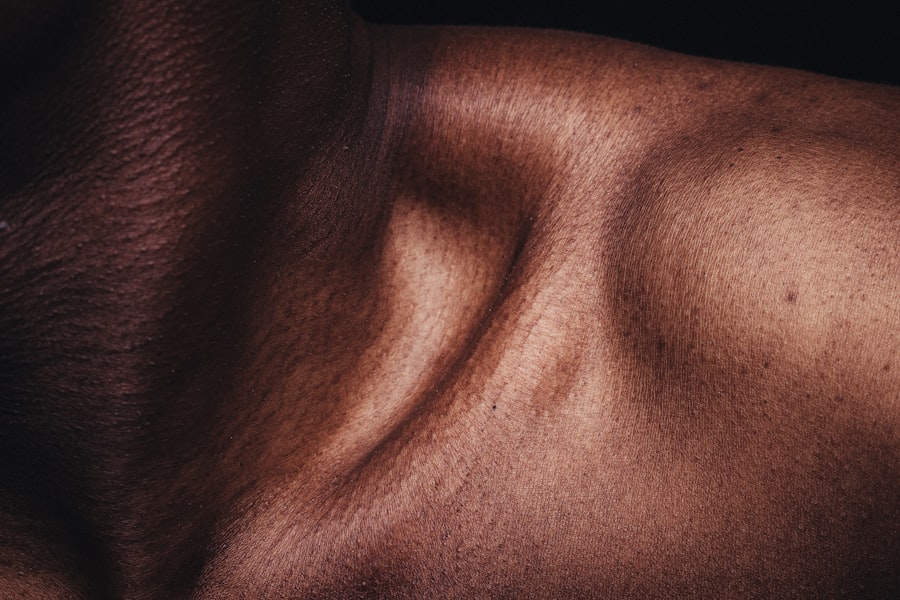Laser hair removal is a popular cosmetic procedure that utilizes concentrated beams of light to target and eliminate unwanted hair. The process begins with the laser emitting a specific wavelength of light that is absorbed by the pigment in the hair follicles. This absorption generates heat, which damages the follicle and inhibits future hair growth.
As you consider this treatment, it’s essential to understand that it typically requires multiple sessions to achieve optimal results, as hair grows in different cycles, and the laser is most effective on hair in the active growth phase. During your initial consultation, your specialist will assess your skin type, hair color, and overall health to determine the best approach for you. They will explain the technology used, the expected number of sessions, and what you can anticipate in terms of results.
Understanding this process not only helps you feel more comfortable but also prepares you for the commitment involved in achieving smooth, hair-free skin. It’s important to remember that while laser hair removal can significantly reduce hair growth, it may not guarantee complete removal for everyone.
Key Takeaways
- Laser hair removal targets hair follicles to inhibit future hair growth
- Look for a specialist with proper certification and experience in laser hair removal
- Shave the treatment area and avoid sun exposure before the procedure
- Pain during laser hair removal can be managed with cooling techniques and numbing creams
- Follow post-treatment care instructions and schedule follow-up treatments as recommended
Choosing a Qualified and Experienced Laser Hair Removal Specialist
Selecting the right specialist for your laser hair removal is crucial to ensuring a safe and effective experience. You should look for a practitioner who is certified and has extensive experience in performing laser hair removal procedures. Research their credentials and read reviews from previous clients to gauge their reputation.
A qualified specialist will not only have the technical skills necessary but will also be knowledgeable about different skin types and hair colors, allowing them to tailor the treatment to your specific needs. During your consultation, don’t hesitate to ask questions about their experience, the types of lasers they use, and their approach to patient care. A good practitioner will take the time to explain the procedure thoroughly and address any concerns you may have.
Trust your instincts; if something feels off or if you don’t feel comfortable with their answers, it’s perfectly acceptable to seek a second opinion. Your safety and satisfaction should always come first.
Preparing Your Skin for Laser Hair Removal
Preparation is key when it comes to laser hair removal. Before your appointment, you should avoid any activities that could irritate your skin, such as waxing or plucking, for at least four weeks prior to treatment. These methods can remove the hair follicle entirely, which is counterproductive to the laser’s effectiveness.
Instead, shaving is recommended as it leaves the follicle intact while allowing the laser to target it effectively. Additionally, you should cleanse the area to be treated thoroughly before your session. This means avoiding lotions, creams, or deodorants on the day of your appointment, as these products can interfere with the laser’s ability to penetrate the skin effectively.
Your specialist may provide specific instructions tailored to your skin type and treatment area, so be sure to follow them closely for the best results.
Avoiding Sun Exposure and Tanning Before Laser Hair Removal
| Metrics | Before Laser Hair Removal |
|---|---|
| Sun Exposure | Avoid direct sun exposure for at least 2 weeks before treatment |
| Tanning | Avoid tanning beds and self-tanning products for at least 2 weeks before treatment |
| Sunscreen | Use sunscreen with SPF 30 or higher if sun exposure cannot be avoided |
One of the most critical aspects of preparing for laser hair removal is avoiding sun exposure and tanning prior to your treatment. Sunburned or tanned skin can increase the risk of complications during the procedure, such as burns or discoloration. Ideally, you should refrain from sunbathing or using tanning beds for at least four weeks before your appointment.
If you have recently been in the sun, inform your specialist so they can assess whether it’s safe to proceed with treatment. In addition to avoiding direct sun exposure, consider using sunscreen on any exposed areas of skin if you must be outside. A broad-spectrum sunscreen with an SPF of 30 or higher can help protect your skin from harmful UV rays while minimizing the risk of complications during your laser treatment.
Taking these precautions not only ensures your safety but also enhances the effectiveness of the procedure.
Managing Pain and Discomfort During Laser Hair Removal
While many people report minimal discomfort during laser hair removal, it’s natural to feel some anxiety about potential pain associated with the procedure. Most modern lasers are equipped with cooling devices that help minimize discomfort by cooling the skin before, during, and after treatment. However, if you are particularly sensitive to pain, discuss this with your specialist beforehand; they may recommend topical anesthetics or other pain management techniques to ensure your comfort.
During the procedure itself, you might feel a sensation similar to a rubber band snapping against your skin as the laser pulses. This sensation varies depending on individual pain tolerance and the area being treated. It’s essential to communicate with your specialist throughout the process; if you experience significant discomfort, they can adjust settings or take breaks as needed.
Remember that managing pain effectively contributes to a more positive experience overall.
Post-Treatment Care and Maintenance

After your laser hair removal session, proper post-treatment care is vital for achieving optimal results and minimizing side effects. You may experience some redness or swelling in the treated area, which is entirely normal and should subside within a few hours to a couple of days. To soothe your skin, apply a cool compress or aloe vera gel as recommended by your specialist.
Avoid hot showers, saunas, or strenuous exercise for at least 24 hours post-treatment to prevent further irritation. Additionally, it’s crucial to keep the treated area clean and moisturized. Your specialist may recommend specific products that are gentle on the skin and free from harsh chemicals or fragrances.
Following their advice will help promote healing and enhance your results. If you notice any unusual symptoms such as excessive swelling or blistering, contact your specialist immediately for guidance.
Setting Realistic Expectations for Laser Hair Removal Results
As you embark on your laser hair removal journey, it’s essential to set realistic expectations regarding the results you can achieve. While many individuals experience significant hair reduction after a series of treatments, complete hair removal is not guaranteed for everyone. Factors such as hair color, skin type, hormonal changes, and genetics can all influence outcomes.
Understanding these variables will help you maintain a positive outlook throughout the process.
Typically, most people require multiple sessions spaced several weeks apart to achieve optimal results.
It’s important to remain patient and committed to the process; many individuals find that their confidence grows as they notice gradual improvements in their skin’s appearance over time.
Following Up with Your Laser Hair Removal Specialist for Additional Treatments
After completing your initial series of laser hair removal sessions, it’s essential to maintain open communication with your specialist regarding any follow-up treatments you may need. Some individuals may require touch-up sessions after their initial treatments to address any remaining hair or new growth that may occur over time.
Regular check-ins with your specialist also allow them to monitor your skin’s response to treatment and make any necessary adjustments for future sessions. This ongoing relationship ensures that you receive personalized care tailored to your needs and helps maximize the effectiveness of your treatments. By staying proactive about follow-up appointments, you can enjoy long-lasting results and maintain smooth skin for years to come.
In conclusion, understanding every aspect of laser hair removal—from preparation and choosing a qualified specialist to post-treatment care—will empower you throughout this transformative journey. By setting realistic expectations and maintaining open communication with your practitioner, you can achieve beautiful results while ensuring a safe and comfortable experience. Embrace this opportunity for self-care and enjoy the confidence that comes with smooth, hair-free skin!
If you’re looking for more information on laser hair removal prep, be sure to check out the blog section on InLaserHairRemoval.com. They offer helpful tips and advice on how to prepare for your laser hair removal treatment. Additionally, you can also visit their sample page here for more details on what to expect during the process. And don’t forget to review their privacy policy here to ensure your information is protected.
FAQs
What is laser hair removal?
Laser hair removal is a cosmetic procedure that uses a concentrated beam of light (laser) to remove unwanted hair. The laser targets the pigment in the hair follicles, damaging them and inhibiting future hair growth.
How should I prepare for laser hair removal?
Before your laser hair removal treatment, it is important to avoid sun exposure and tanning beds, as well as plucking, waxing, or electrolysis for at least six weeks. Shaving is typically allowed and recommended before the treatment.
Is there anything I should avoid before laser hair removal?
Before laser hair removal, it is important to avoid using any products that may irritate the skin, such as retinoids, exfoliants, or harsh chemicals. It is also recommended to avoid sun exposure and tanning beds to reduce the risk of skin damage.
Can I use numbing cream before laser hair removal?
Some individuals may choose to use a numbing cream before laser hair removal to minimize discomfort during the procedure. It is important to consult with your healthcare provider or the laser hair removal technician before using any numbing cream to ensure it is safe and appropriate for the treatment.
How many laser hair removal sessions will I need?
The number of laser hair removal sessions needed varies depending on the individual’s hair type, skin color, and the area being treated. Most people require multiple sessions, typically spaced 4-6 weeks apart, to achieve optimal results.






